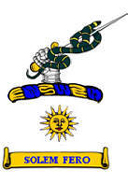|
THE
PYRENEES
|
During the years
1836-1860, Mereweather recorded in a book of Memoranda
quotations in poetry and prose from various authors. He
also wrote down his own thoughts, poems and narratives.
In 1832, just before his sixteenth
birthday, Mereweather made a tour of the French
department of the Hautes-Pyrénées. The following
narrative was written down around the year-end of 1843
(pages 125-152). Paragraph breaks have been
inserted. Various
illustrations have been added. |
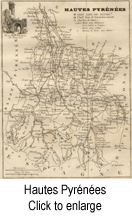 |
A Tour in the Pyrenees
Scorched by the sun who had exerted his most powerful
influence during the summer without intermission, and nearly
smothered by the dust, which after the excessive drought had
amassed itself to many inches in depth, I longed to leave
Bordeaux for a time to breathe the pure and cool air which
ever circulates among the Pyrenees, mountains abounding with
magnificence and sublimity of scenery scarcely to be
surpassed.
Accordingly, having taken my place some days previously, on
Tuesday the 21st of August 1832, I found myself at 7 in the
morning on the top of M. Dotezac’s heavy diligence drawn by
seven bulky but well fed grey horses with collars having
loudly tinkling bells attached to them.
I may here mention that the French seem very fond of all
sorts of noises, but especially of three, bells, drums and cur
dogs, one being scarcely able to pass a cart but he hears the
jingling of bells attached to the horse’s neck, scarcely able
to walk in a principal street but he hears the deafening noise
of a drum which some poor drummer is doomed to beat as he
walks for a certain space of time, and scarcely able to pass a
country dwelling but the shrill bark of some cur kindly awakes
him from any reverie into which he might have fallen.
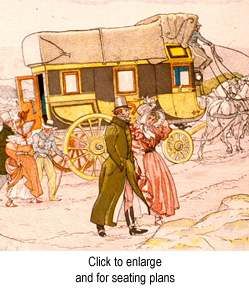 Well, I got on the coach early in the morning in high
spirits; but you must not imagine that the French
diligences resemble our little light vehicles which four
small but well bred horses can make to fly over the
ground at the rate of ten miles per hour. On the
contrary, the French coach has four distinct
compartments. The first of these with regard to price
and comfort is designated the Coupé. This apartment has
one side only, in fact just like a chariot, and will
contain three persons. The second and middle, called the
Intérieur, is made for six people, and though not so
expensive as the Coupé, yet contains very respectable
company. The third apartment, the Rotonde, is behind
all, contains about the same number as the middle one
and is usually filled by servants and people of the
lower class. Then comes the Banquet or Impériale on the
top of the coach which has a cover like a cabriolet to
be raised or let down at pleasure; it has also a leather
to come over the knees. This is intended for the same
class of persons as the Rotonde, but I prefer it to all
the others, as the passenger is able to have a perfect
view of all the surrounding country, and is completely
protected from the weather. Well, I got on the coach early in the morning in high
spirits; but you must not imagine that the French
diligences resemble our little light vehicles which four
small but well bred horses can make to fly over the
ground at the rate of ten miles per hour. On the
contrary, the French coach has four distinct
compartments. The first of these with regard to price
and comfort is designated the Coupé. This apartment has
one side only, in fact just like a chariot, and will
contain three persons. The second and middle, called the
Intérieur, is made for six people, and though not so
expensive as the Coupé, yet contains very respectable
company. The third apartment, the Rotonde, is behind
all, contains about the same number as the middle one
and is usually filled by servants and people of the
lower class. Then comes the Banquet or Impériale on the
top of the coach which has a cover like a cabriolet to
be raised or let down at pleasure; it has also a leather
to come over the knees. This is intended for the same
class of persons as the Rotonde, but I prefer it to all
the others, as the passenger is able to have a perfect
view of all the surrounding country, and is completely
protected from the weather.
|
However! To return to my tour. Having passed through
Castres and Langon, we soon came into the department of the
Landes which may be distinguished from that of the Gironde by
its black, marshy and uncultivated soil with few trees. The
shepherds here use high stilts to traverse the swampy
pastures, so that when I saw one of them stalking after his
flock, he put me in mind of Polyphemus. When Buonaparte passed
through this department on his way to Bayonne, the inhabitants
formed a guard of honour on stilts to escort him through their
country.
Towards evening, in the midst of a tremendous thunderstorm,
the diligence arrived at Mont St Marsan, a pretty considerable
town halfway between Bordeaux and Pau. In the morning the
change of scenery announced our arrival in the department of
the Basses Pyrénées [Pyrénées-Atlantiques]. The country now
began to appear more luxuriant, more cultivated, and not so
flat as the Landes; the cottages also were more numerous.
These have at a distance a very pretty effect, but only at a
distance, for on a closer examination they are found to have a
very wretched appearance, which with the addition of a pig and
some dirty children amusing themselves all in the strictest
amity before the door, gives them the air of an Irish
cabin.
At last, after a very hot ride, and almost choked by the
dust, I arrived at noon in Pau (120 miles in 30 hours), in my
opinion the prettiest town in the Pyrenees, and then after
necessary ablutions, hastened forth to see the famed Château
de Henri Quatre, generally called Henri le Grand.
Before I proceed farther, it may be well to give a short
sketch of the history of this castle. According to Froissard
this castle was erected by Gaston Phoebus, Count of Foix and
Prince of Béarn, about the year 1363. This nobleman built four
towers to which a fourth [sic] was added by Henri who was born
there, and whose cradle, an entire tortoiseshell, I saw under
a canopy placed there by order of Louis Quinze. The castle
suffered much during the revolution; the sculpture was defaced
and many souvenirs of Henri were totally destroyed. The cradle
even would have fallen a prey to the fury of an enraged mob,
if an individual had not taken it, and supplied its place with
another, which was soon dashed to pieces. All the rooms,
except that in which the cradle lies in state, are in very bad
preservation, being mostly without flooring. After returning I
dined at the table d’hôte, where the table groaned under a
multitude of dishes.
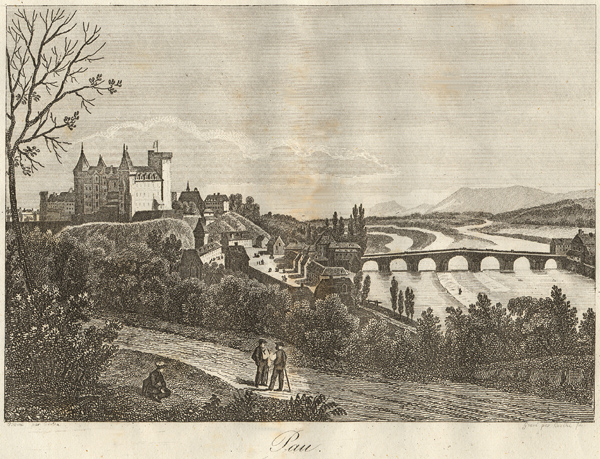
Pau, from France Pittoresque, 1835
During dinner I made acquaintance with a young German
who was travelling with his tutor, and in the evening I went
with him and some others to the Haras or stables where the
breed of horses is carefully kept up for the exclusive use of
the government. I saw some very nice horses there: a young
Arab in a paddock with its dam particularly attracted my
attention.
On the following morning, Thursday Aug. 23rd, I started for
Bagnères de Bigorre. On our way we passed through Tarbes, a
large town in the midst of an extensive and well watered
plain. After that we approached the Pyrenees, the sight of
which caused my heart to throb with a strange but not
unpleasing sensation. I felt proud at having mustered
sufficient courage to leave my friends behind me at the
distance of more than 40 leagues, and thus go without a guide
or even a companion at so early an age to throw myself among
strangers, and those foreigners.
Behind me was the fertile valley smiling under the rays of
a summer’s sun; before me were the black mountains towering
above thunder clouds still blacker, and which had in vain
attempted to overtop them. For a time I was lost in
admiration; but the sight of the lovely populous country
around me soon brought me to my senses. In a space of six
miles we passed through six villages containing good houses
some of which had beautiful gardens attached to them: in one
of these I observed a fine obelisk cut out of one entire piece
of marble.
And now the mountains seem nearer and nearer, and now we
enter Bagnères de Bigorre which is nearly surrounded by their
giant forms, and soon I found myself seated at the Hôtel de
France, the principal hotel in Bagnères, before a good dinner
at 6 o’clock in the evening.
The next day, Friday Aug. 24th, I ascended a mountain which
overhangs the town to try my pistols. When on the summit, I
had full opportunity of observing the situation of the town
which lay at my feet. It is placed between the fertile
province of Bigorre and the luxuriant Vallée de Campan. I
could easily distinguish the stately buildings which are
erected over the mineral waters. Les Bains de la Reine, Les
Bains Caseaux, La Fontaine d’Angoulème are all famous in their
way for their wonderful cures. The houses in Bagnères are
excellent, and the streets are delightfully clean owing to the
numerous rivulets which descend from the mountains, so that
the town is very much resorted to by strangers.
And now behold me at 11 o’clock next morning, seated on a
very small poney, which I had hired for three francs a-day,
with my portmanteau and cloak strapped in due form before and
behind me, on my way into the mountains. I took the route
towards Tarbes until I reached the pretty village of
Montgaillard, when I turned short off to the left, following
the road to Lourdes. I now began to be surrounded by mountains
which by their black and frowning appearance announced
themselves to be the Pyrenees. And now I could see the castle
of Lourdes on a rock towering above the town, so I soon found
myself at the Hôtel de Poste refreshing myself after a hot and
fatiguing ride of ten miles.
However! No time was to be lost, my day’s journey was not
nearly done, so I jumped up and after a steep and circuitous
ascent gained the castle which completely commands all the
adjacent country. This fortress was formerly the residence of
the Counts of Bigorre and is of great age, having formerly
been attacked by our king John. It now has a garrison of 100
men with a few pieces of artillery. From the tower I could
discern four grand routes. Before me lay the road to Argelès,
behind me to Tarbes, that on my right led to Pau, and that on
my left to Bagnères de Bigorre which I had just left.
Having descended from the chateau, I mounted and proceeded
by the side of a foaming torrent called a Gave and through a
lovely valley to Argelès which is situated in a plain. After
Argelès the scenery began to be more terrible every moment.
Immense cliffs, to which St Vincent’s rock at the Bristol
Hotwells is but a cipher, overhung the right side of the road
covered with clouds : on my left the Gave de Pau foamed
impetuously by. After passing through several villages I
arrived at Pierrefitte, a small place about eight miles from
Cauterets. The night and drizzling storms were now falling
fast around me, so I rode on as fast as my jaded poney would
go, more intent about keeping him on his legs than admiring
the terrific and interesting scenery on either hand.
Wet and tired did I arrive at the Lion d’Or in Cauterets,
wet and tired did I pass the night; for my bed was very damp,
and the asthmatic groans of a sick man in an adjoining chamber
acted rather as the admonitory "il faut mourir, mon frère" of
the Trappistes than as an incentive to to sleep.
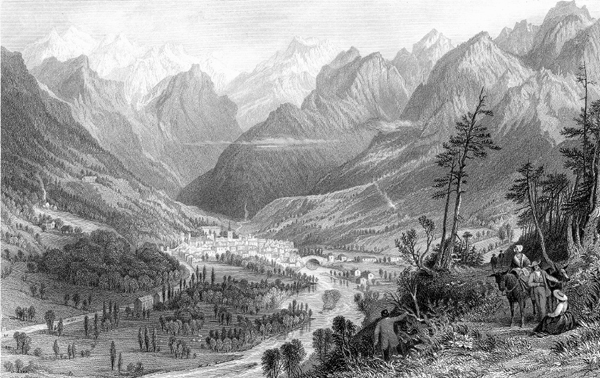
Cauterets, drawn by Thomas Allom, engraved by S. Fisher, c.
1850
On Sunday I attended the dog market which is
held weekly in Cauterets, the peasants bringing down these
animals from the mountains, when they descend to attend
mass. I bought a pup of the mountain breed
– véritable espèce
– for
six francs. I at first objected to him fearing that, from his
then appearance, he would never be very large; but my mouth
was soon stopped by a mountaineer chorus of "Mon Dieu,
Monsieur, il sera monstre" and certainly in aftertimes when I
watched him stalking majestically by my side far overtopping
all the dogs around him, like Agamemnon among his compeers, I
considered that I had no reason to repent of my purchase.
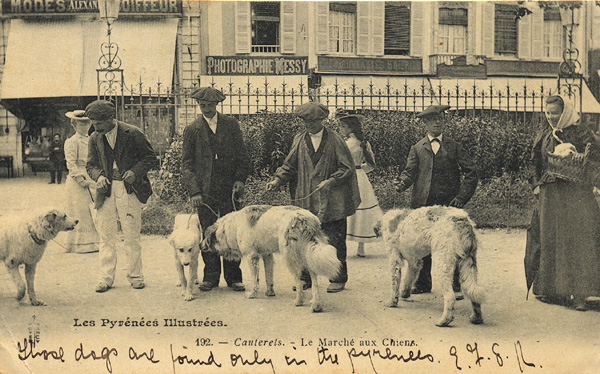
Cauterets, The Dog Market, card
postmarked 1905
Cauterets is entirely surrounded
by lofty mountains, consequently unapproachable by horses or
carriages except on the Pierrefitte side. It has three baths
all warm, the principal of which, La Raillère, owes its
discovery to a cow. I amused myself for an hour or two in the
forenoon by clambering up an adjacent mountain, and as I
toiled up a steep and difficult ascent a mountaineer passed
swiftly by closely followed by three goats. These animals,
frightened at the sight of a stranger, bounded up on a lofty
rock overhanging the path with incredible agility and then
darted down again, as soon as I had passed, to follow their
master.
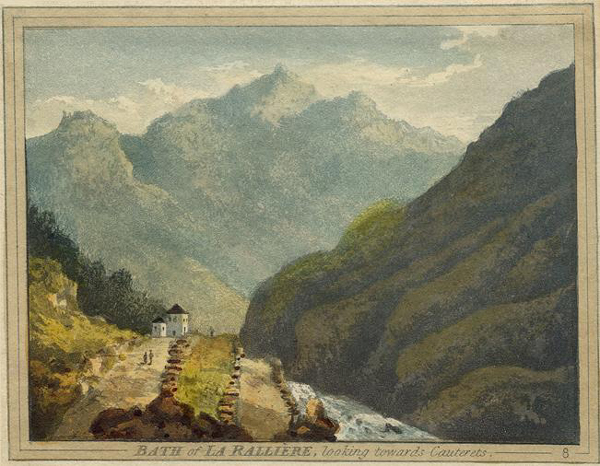
Bath of La Raillère towards Cauterets
Aquatint
from Joseph Hardy, A Picturesque and Descriptive
Tour in the Mountains of the High Pyrenees,
London 1825
Next morning at ½ past five, accompanied by a guide who as
well as myself had in his hand a long pole shod with iron, I
set out for the Vignemale, the highest mountain of the French
Pyrenees, being 3356 metres = 10907 feet above the level of
the sea. Having passed the baths called La Raillère, we
arrived at the Cascade de Ceriziet [Ceriset], a picturesque
fall of about forty feet. It was after that that the scenery
became so majestically wild. This combined with the increasing
rarity of the air brought on a kind of delirium which I had
some difficulty in checking.
After passing another fine cascade called Boussès, we
arrived at the Pont d’Espagne, on which travellers have in
vain exhausted their descriptions. I stood upon a slender
bridge formed of the trunks of three of four pines negligently
flung across a chasm of 100 feet in depth under which the
Gave, after tumbling tumultuously down a precipice, rushed
furiously. The deafening roar of the wild waters, their greedy
rushing through the narrow bourn, the rocks, abysses and
wildnesses on all sides of me; all this, combined with the
sharp and clear atmosphere, produced such an effect on me,
leaning as I was over the frail parapet of the bridge, as I
certainly should not wish repeated under similar
circumstances.
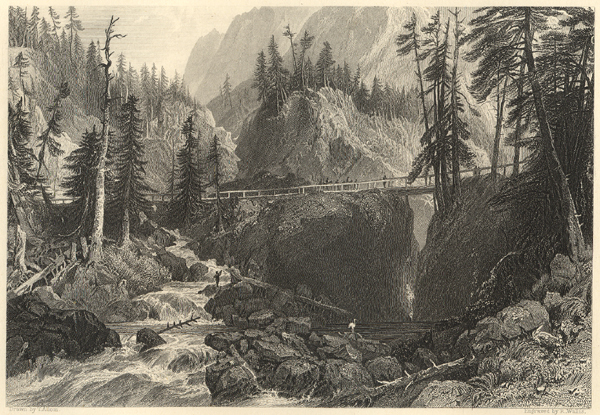
Pont d’Espagne, drawn by Thomas Allom, engraved by R.
Wallis, c. 1860
After walking some distance farther
we arrived at the Lac de Gaube which is fed by mountain
streams that worm their way down the lofty steeps surrounding
it on every side. At the lake the scenery is very striking.
Behind me were mountains through the almost impassable paths
of which I had come; at my feet was the blue and deep lake
nearly motionless; on the right and left were lofty cliffs
which seemed to have risen out of the waters by enchantment,
and on the sides of which unscaleable by man I could see the
wild chamois bounding; and before me, towering above all, rose
the lofty Vignemale, his head enveloped with clouds and
everlasting snows.
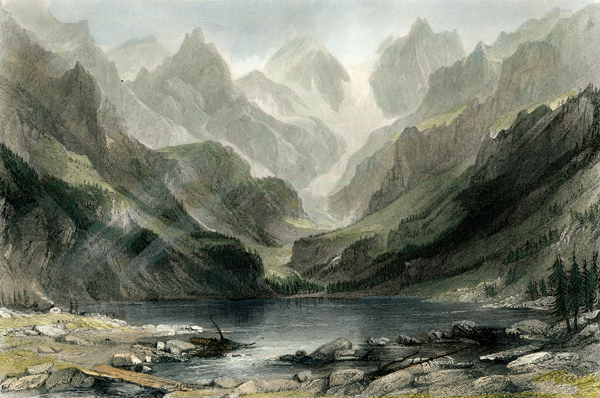
Lac de Gaube, drawn by Thomas Allom, engraved by J. C. Bentley,
from France Illustrated,1840
My guide and I breakfasted on the banks of the lake hard by
an old fisherman’s cottage, the inhabitant of which has
resided there during the four summer months for the last 30
years. His name is Gaye, and he is 90 years old; nevertheless,
he rowed us over the lake with the agility of youth. Having
crossed, we bent our steps towards the Vignemale. The scenery
now began to change: the space between the mountains on either
hand became wider and was completely choked up with immense
stones which descend from the mountains in spring at the
melting of the snows.
At noon we arrived at the glacier of the Vignemale and
walked over the snow which was very hard. After writing your
name, my dear, on the enduring snow with the iron point of my
staff, I sat down on the ground and partook of the contents of
the guide’s wallet. Seldom does it befal mortals to have such
superb witnesses to their repasts as it then befel my guide
and me. Before us were the three peaks of the Vignemale, the
highest of which inaccessible to mortal footstep was
surrounded by mist. On our right and left were two lofty
cliffs: over the left height is carried the path which leads
into Spain whence we were not many miles distant. The valley
in which we were was full of desolation: no verdure, no trees,
no water; but instead a chaos of huge rocks rent by
convulsions from the neighbouring heights, and paving the
surface of the earth, huge and unequal.
| We saw herds of chamois sporting over the snow; shortly
afterwards there was the sharp crack of a rifle, and presently
a huntsman appeared with his prey, an izard (for thus is
called the wild goat of the Pyrenees) slung round his neck.
These izards are much smaller than a goat with large sharp
horns very crooked: they are wonderfully fleet. We now
returned by the same way that we came and arrived at the inn
at ½ past five, having walked during twelve hours with
scarcely any intermission. |
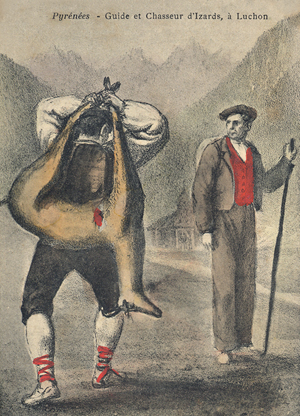 |
Guide
and Izard Huntsman
Card
postmarked 1905
|
At break of next day I set out for Luz which place I
attained by noon after passing among some glorious scenery.
After breakfast I set out to see the famous Cascades de
Gavarnie, an excursion carefully to be remembered by me, since
my life on that day was in the most imminent peril. I ought to
have had a guide which precaution I neglected. I was wrong too
in starting so late in the day, for travellers usually start
for these cascades at eight in the morning. I soon left on my
right the pretty village of St Sauveur, and struck into a path
so dangerous, surrounded by scenery so wild that I shuddered
to pass it in the day, little thinking that it would be so
soon my fate to grope my return in the blackest night.
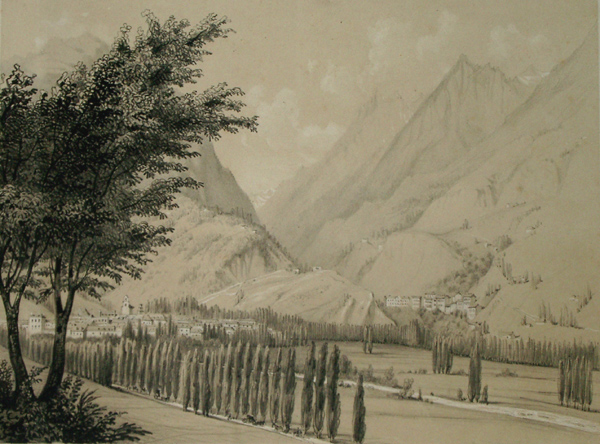
Luz & St Sauveur
Drawing by E. Paris, lithograph by Thierry Frères, Paris,
from the mid-1800s
The path for the whole distance (nearly 14 miles) was cut
out of or rather over huge masses of slippery rock. It was not
above four feet in width, having on one side an abrupt
precipice of 300 feet in depth at the bottom of which bounded
onward an impetuous Gave, and overhung on the other side by
rocks equally high. The scenery became more stupendous as I
advanced. The path repeatedly wound round huge masses of rocks
as big as palaces which had been torn from the adjacent
summits; and in the distance I could discern with difficulty
some towering peak wrapped round with mist.
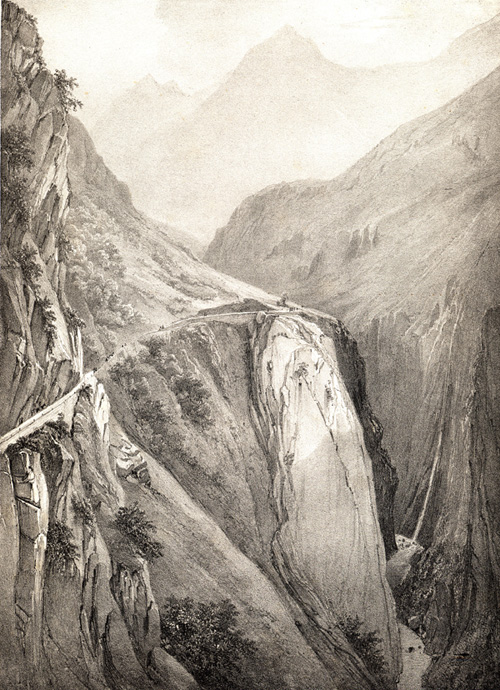
Le Pas de L’Échelle, the route from
Luz St Sauveur to Gavarnie
Depicted and lithographed by Julien Jacottet, Paris c.
1840
At five in the afternoon the cascade of Gavarnie broke upon
my sight. To find words to describe what I then saw would be
impossible. You must imagine, my dear , a vast sheet of water
precipitating itself down a height of not less than 1266 feet
and boiling in the basin below. The clouds which floated about
amidst this vast amphitheatre of rocks gave an unearthly
appearance to the scene. Æschylus might have chained his
Prometheus to one of these lofty summits without detracting
from the sublimity of his wonderful tragedy.
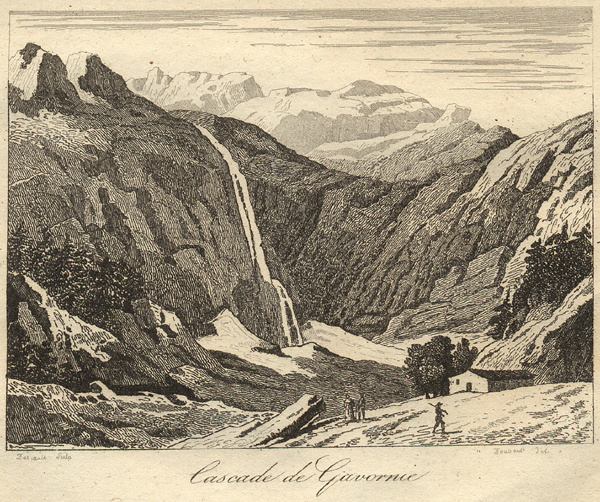
Cascade de Gavarnie, from France
Pittoresque, 1835
I now turned my poney’s head
towards Luz. A rain was falling from the mist, but it was
still light when I arrived in two hours and a half at
Gavarnie, a small and miserable hamlet situated halfway
between the cascades and Luz. I had now seven miles of the
most dangerous part of the journey to travel over, and before
I had lost sight of the village, darkness came on. I was then
stopped and questioned by one of the gendarmerie which made me
later. Another mile and I could not see my poney’s head, for
the rain fell heavily, the night swiftly, and the mist
thickly. I had three bridges to cross, two of which were of
the rudest description. I passed one bridge, but I should not
have known that I was passing it, if the noise of the Gave
beneath had not outsounded the elements. As I was spurring the
poney to pass over the second, two huge dogs sprang out from a
cleft in the rock and jumped up at me barking loudly. These
were soon followed by their master, some shepherd with a
lantern who lighted me over the frail planks.
As I continued my journey, I could feel (seeing was out of
the question) my foot brushing the bushes which overhung the
precipice. By and bye the poney stopped conscious of the
danger and not able to see the way. This much dispirited me as
I had for some miles been trusting myself entirely to him.
However, after commending myself to Providence I urged him on,
and we proceeded for some distance. He stopped again, and
refused to go any farther. I dismounted that I might grope the
way on foot, and slipped so that I found myself sitting with
my two feet hanging over the edge of the abyss. The Gave
seemed to laugh exultingly at receiving a fresh victim, for
many had fallen into the torrent never to return, but the
poney hearing me slip as I fell was startled and pulled me
back by the bridle which luckily I held tightly, so I struck
off in another direction which proved the right.
After proceeding a long way, every moment expecting to slip
over the cliff, which catastrophe the poney adroitly eluded,
how great was my joy to perceive the lights of St Sauveur. I
then knew that I was but a quarter of a mile of good road from
Luz: however, the only accident which happened to me at all
was between these two places. As I was cautiously leading my
poney along, I fell into a sort of ditch nine feet deep and
should have pulled him over me if the bridle had not slipped
over his head.
Wet frightened and scratched, hungry and sleepy I entered
the town of Luz at ½ past ten at night. Not a light was in any
of the windows, and my late adventures had totally obliterated
from my memory all traces of the whereabouts of my hostelerie.
Once more I trusted to my poney; I got on his back, threw the
reins on his neck and ere long stood before the inn where I
astonished the inmates with an account of my excursion.
Next morning I proceeded to Barrèges, a town much more
celebrated for its waters than its fine buildings. It was then
exceedingly full of company. From Barrèges I struck into a
path leading over the Tourmalet, a chain of mountains which it
is necessary to cross in going to Bagnères de Bigorre.The
scenery on the vast ridges of the Tourmalet was wild and
desolate, the track tedious, lonely and difficult. When,
however, I had ascended a cloud-capped mountain, I began
rapidly to descend into a valley completely filled by a dense,
white mist which emitted a heavy shower.
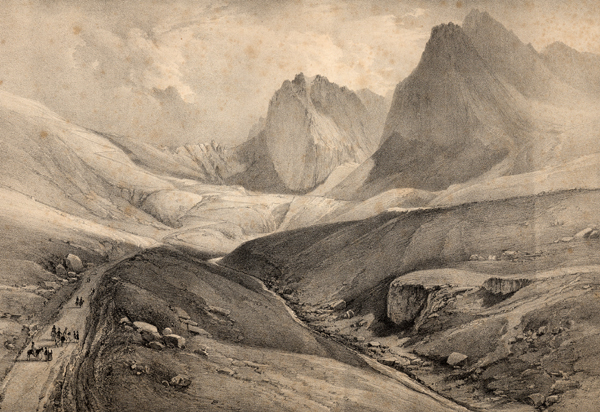
Le Col de Tourmalet, the route from Barèges to Bagnères
de Bigorre
Depicted and lithographed by Julien Jacottet, Paris c. 1840
After a very uncomfortable journey, owing to the rain [and]
the fear of being benighted in a country where, if I had
missed the slight track on which I depended, I might have
wandered several days without seeing anyone, owing too to the
fatigue of my dog which I was frequently obliged to fling over
the saddle whilst I walked, Gripp was at length gained, a
village consisting of numberless cottages, each situated in
the midst of its own meadow. Night forced me to stop there,
although Bagnères was only six miles distant, so I surrendered
myself to the excellent accommodation of the Hôtel de Gripp.
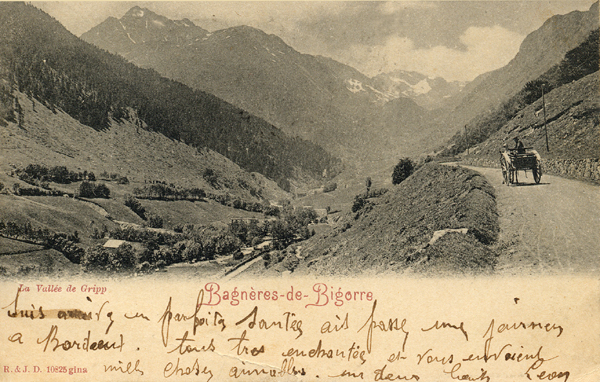
The Gripp Valley, card postmarked 1901
Next morning rising with the sun, which promised a lovely
day, I started for Bagnères, my road lying through the
charming valley Campan. I was accompanied to the nearest
village, St Marie, I think, by the landlady’s daughter, a
pretty child of 10 years of age who, mounted on a donkey, was
going to buy bread. She beguiled the way by telling me a
wonderful story of a monster which like the dragon of Rhodes
had devastated the country of late. According to her this
creature was immensely large, and had the body of a bear with
the head of a bulldog. It had eaten three weeks before four
horses, seven cows and, to crown all, an old woman. She added
that on the following Sunday after mass there would be a
general hunt to take and kill the brute.
And now the lovely valley became more lovely every moment.
The green and luxuriant pastures speckled with innumerable
cottages and beyond these the many peaks, whose eternal snows
glittered like silver in the sun, made a fine contrast with
the black and barren rocks which frowned on the opposite side.
At 10 o’clock on Thursday the 30th of August I arrived at
Bagnères having been absent on my mountain excursion during
five days.
On Sunday I went to Gripp with an Englishman to see the
monster hunt, but we found that it had been deferred until the
Sunday following, so we went on to the Pic du Midi which is
only to be surpassed in height by the Vignemale being 2973
metres = 9662 feet above the level of the sea. The extreme
heat of the day prevented us from ascending, so we contented
ourselves by contemplating its vast proportions. It seemed a
vast rock and is exceedingly steep requiring three hours to
ascend and two to descend. We sat down on the grass and
conversed with three old shepherds: when we [were] about to
depart my friend gave them 30 sous between them. They were so
amazed at this generosity that they wished to return half. On
our return to Bagnères in the evening we encountered troops of
young villageoises who, clad in picturesque costume, came to
offer bouquets of choice flowers.
Monday saw me arrived at Pau where circumstances compelled
me to stay until the Thursday following. The more I saw of Pau
the more I was enchanted with it. I prefer it much to the
towns in the centre of the Pyrenees. The distant view of the
Pyrenees as seen from Pau pleases me more than the black
mountains or rather rocks which overhang Bagnères and
Cauterets.
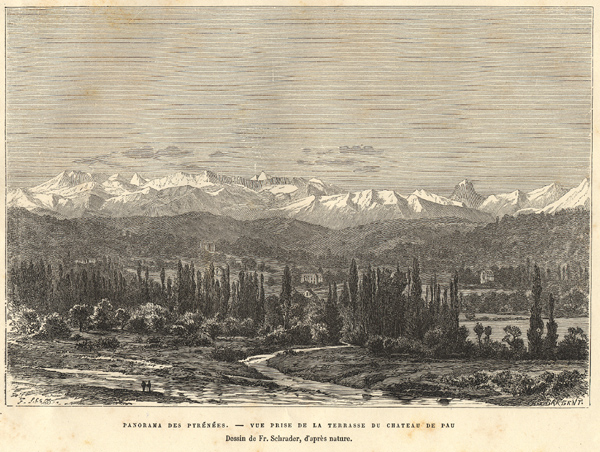
Panorama of the Pyrenees as seen from Pau, c.
1880
Pau possesses five promenades two of which are
truly charming: one is in the middle of the town; the second
is higher up and is chiefly used by the military. Another is
from the terrace of the chateau whence is to be seen a lovely
river rolling through the plain below; beyond that lofty yet
luxuriant hills, and much farther still, so enveloped by
clouds that at first view they might be mistaken for clouds,
the black Pyrenees. The fourth is by the side of a small
stream which hastens to throw itself into the river. The last
is by the side of the limpid river which may be seen filled
with carts drawn by oxen, whilst the drivers are busily
employed in loading them with stones, which they pick up from
the bed of the stream.
On Thursday the 6th of September I started for Bordeaux
where I arrived on Friday morning (my birthday, being 16 years
of age) safe and sound, thank God, after laughing heartily all
the way, there being in the same part of the Diligence as
myself all sorts of animals, as a man remarked, English,
Gascons, Parisians, French poodles, 2 huge Pyrenean dogs,
squirrels and ferrets. The odour arising from such a
congregation was not, as you may suppose, the most
agreeable.
|
